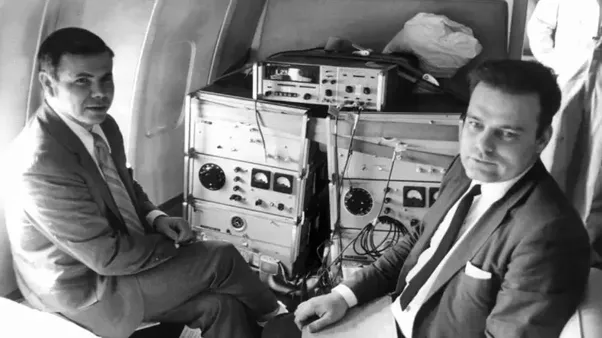https://www.biography.com/.image/t_share/MTQ1MTQxMzc4OTc0NzU0MjAw/albert-einstein---mini-biography.jpg
**PART FOUR: EXPERIMENTAL EVIDENCE (AND THE LACK THEREOF)**
The reader will likely recall that in 2011 a team of scientists at CERN claimed to have detected “faster than light neutrinos,” the existence of which supposedly disproved Special Relativity. The reader will probably also recall that this claim was later dismissed, blamed on a loose fiber optic cable, and the scientific world breathed a collective sigh of relief. The second postulate had already long since been disproved, however, by direct and credible evidence.
We have already discussed in Pt. 3 the proven effect of gravity upon the velocity of light. The omnipresence of gravity precludes any conceivable location where the second postulate could be applicable, yet this knowledge does not disprove the assertion of the cosmic speed limit c. This job has been accomplished elsewhere, however, in the observation of radio galaxies, BL Lac objects, quasars, and micro-quasars, each of which have been known to eject plasma jets with velocities several times higher than c. These startling observations have regrettably been dismissed as the results of optical illusion. The argument goes that, when the luminous jets point toward our line of sight, light from the jets does not move toward us very much faster than the jets themselves, and consequently light emitted over hundreds of years arrives in our telescope lenses over a much shorter period of time. The problem with this argument is that many of these jets *do not* point toward our line of sight. For example, superluminal motion greater than 6c has been observed from the jet Messier 87. To explain this in terms of the narrow angle model, the jet must be moving within 19° of our line of sight, when in fact it is moving at 43°. Another jet, 3C 273, has an outer band which is nearly parallel to our line of sight. Its inner band is *not* parallel to our line of sight, and yet in this band we have observed superluminal motion approaching 10c.
To most, these examples will inevitably ring hollow, and the burden of proof will still rest upon those who would seek to discredit Special Relativity. To this we must reply: what evidence has ever been presented *for* Special Relativity? Numerous experiments are purported to have confirmed light invariance and time dilation, including the Ives-Stilwell experiment, the Kennedy-Thorndike experiment, measurements of muon lifespan variation, and the Hafele-Keating experiment, but not one of these experiments cogently dictates an invariable speed of light. The Hafele-Keating experiment is the only experiment which unquestionably confirms the time dilation effect (whether that effect be real or apparent), but in doing so it demonstrates that the observed changes in time rate and the cause of those changes are inconsistent with the model proposed by Special Relativity. To support these statements, we will examine and assess each of these experiments individually.
**The Kennedy-Thorndike Experiment**
The Kennedy-Thorndike experiment of 1932 was virtually identical to the Michelson-Morley experiment. The only notable differences were that one arm of the inferometer was made shorter than the other and the experiment was performed at various times throughout the year, so that in each iteration the Earth’s velocity would be different in direction and, to a smaller extent, magnitude. It was suggested that in the absence of a Lorentz-Fitzgerald transformation, the varying velocity of the Earth should cause observable phase shifts in the light that would be exaggerated by the uneven lengths of the inferometer arms. As one would expect from our discussion of the Michelson-Morley experiment, a phase shift was not detected in the Kennedy-Thorndike experiment either. The null result was attributed, of course, to light speed invariance, length contraction, and time dilation, but these conclusions were reached using the same erroneous premise that plagued the Michelson-Morley experiment— that the movement of the Earth should affect the relative velocities of the apparatus and the light emitted by it. Whether the Earth’s velocity be parallel with one of the light beams or perpendicular, the apparatus of the Kennedy-Thorndike experiment would neither chase nor recede from the emitted beam, and we have no reason to expect that the velocity of the Earth would affect the relative velocity between the light and the emitting apparatus. Phase shift should only be expected to occur if the apparatus were substantially accelerated after the light was emitted and before it returned.
<center>https://upload.wikimedia.org/wikipedia/commons/thumb/d/d4/Kennedy-Thorndike_experiment_DE.svg/500px-Kennedy-Thorndike_experiment_DE.svg.png</center>
<center>[Image Source](https://upload.wikimedia.org/wikipedia/commons/thumb/d/d4/Kennedy-Thorndike_experiment_DE.svg/500px-Kennedy-Thorndike_experiment_DE.svg.png)</center>
It may be objected, however, that we are not in an inertial system— the spin of the Earth and the orbit of the Earth around the sun subtly accelerate the apparatus as the light travels. While this is true, we should not expect it to have any bearing on the null result. Firstly, the accelerations will be nearly identical between each iteration of the experiment, so there will be no discernible variation in the phase shifts from test to test. Secondly, the acceleration undergone by the apparatus is far too small to have a visible effect on a wave of light completing a circuit in a matter of nanoseconds. In the time it takes for light to traverse one meter, the Earth spins roughly .000001557 meters along its equator. It is absurd to think centripetal accelerations in this order of magnitude would not only have a discernable effect on the wave interference pattern but also produce a variety of discernable effects through subsequent iterations. The null result of the experiment should be expected even in the classical model of optics, and thus the null result can say nothing about time dilation, length contraction, or light speed invariance.
**The Ives-Stillwell Experiments**
The Ives-Stilwell Experiments of 1938 and 1941 intended to detect the “Transverse Doppler Effect” predicted by Special Relativity. It was believed that time dilation would cause an additional Doppler shift in the frequency of light emitted from a source in motion with respect to the observer. This additional shift, it was believed, would only be detectable when the motion of the light source was perpendicular to the path of the emitted light to the observer. At all other angles, the effect would be indistinguishable from the regular, “longitudinal” Doppler shift that had already been well accounted for using classical mechanics. Ives and Stilwell found that it was actually impossible to measure the Transverse Effect directly, because there was no way to ensure that the detected light rays were emitted at a right angle with respect to the movement of the light source. They decided instead to take the average between the two extremes, 0° and 180°. They believed the average between these values would closely approximate the value at 90°, where no frequency shift is expected in classical theory. If the average differed significantly from the standard light frequency in the absence of source motion or longitudinal Doppler shifts, then it would seem to indicate a failure of classical theory and a confirmation of Special Relativity.
<center></center>
<center>[Image Source](https://en.wikipedia.org/wiki/Ives%E2%80%93Stilwell_experiment)</center>
The shortcomings of the original Ives-Stilwell experiment have been exhaustively detailed in scientific literature. The first problem is the crucial but baseless assumption that the average of longitudinal Doppler shifts will accurately yield the transverse shift. Additional problems include major discrepancies and omissions in the data, as well as the fact that the majority of the measured results fell outside of the stated experimental error, which was large to begin with. It is also worth mentioning that at the low velocities used in the experiments, the predictions of Special Relativity and classical theory were very nearly identical. In many cases, the classical predictions more closely approximated the observed results. Due to its presumptuous theoretical basis, its broad experimental error, its failure to consistently obtain results within that experimental error, and its failure to demonstrate a greater accuracy compared to classical theory, the Ives-Stilwell experiment offers nothing to support or discredit Einstein’s theory. However, similar experiments aimed at detecting the Transverse Doppler Effect have been repeated with alternative means and equipment, so we will have to address these experiments as well before we can dismiss TDE altogether.
The Otting Experiment claimed to have detected a transverse wavelength shift of .026 Å, until it was discovered that Otting had used an erroneous value for the rest wavelength for the Hydrogen line. In actuality, the average of the longitudinal effects fell perfectly within the range of measured rest wavelengths, demonstrating no accord with Special Relativistic predictions.
The 1962 Mandelberg-Whitten experiment relied upon the same value used by Otting for the rest wavelength of the Hydrogen line, a value which had been measured almost fifty years earlier in 1914. The uncertainty in the measured wavelengths were thousands of times greater than should have been permissable with the ion velocities used, and the experimenters also allowed an excessively large margin of error in the viewing angle θ, so that the observed spectral lines were asymmetrically broadened and blurred. Still, they used the mid-position of these blurred lines in conjunction with an erroneous rest wavelength and an erroneous value for θ to declare the existence of a transverse Doppler shift.
**The Mössbauer Rotor Experiments**
Mössbauer rotor experiments, first performed in 1960, involved firing gamma rays at a rotating absorber. Time dilation dictates that the characteristic resonance absorption frequency of the absorber will decrease and more gamma rays will be absorbed when the absorber is in motion relative to the source of the rays. Indeed, multiple experiments showed that more gamma rays were absorbed while the absorber was spinning around the emitter. In 2016, however, it was proved that periodic vibrations caused by the movement of the apparatus lead to a shift in the resonance absorption frequency which ”exhibits the same behavior as the observed relative shift.” Consequently, we have no basis to say that time dilation affected the resonance absorption frequency and the Mössbauer rotor experiments say nothing about the validity or invalidity of Special Relativity.
**Atmospheric Muon Experiments**

<center>[Image Source](https://www.youtube.com/watch?v=3CeQXsIiGp8)</center>
Since as early as 1960, estimations of muon lifespan have been touted as evidence for the validity of Special Relativity. The majority of muons found in our Earthly environment are created in the upper atmosphere (∼ 15km) as secondary products of interactions between highly energetic cosmic rays and the nuclei of atmospheric particles. They are the direct result of decay of two different species of pions, π− and π+. They interact weakly with other particles and have a mass much greater than that of the electron, making them adept at traveling unimpeded. Due to their short lifespan, however, they should not be capable of traveling from the high atmosphere all the way to the surface of the Earth. When held at rest, muons have an average lifespan of 2.2 microseconds. When travelling at velocity c, they should only be capable of traversing around 660 meters in 2.2 microseconds. The overabundance of muons at the Earth’s surface suggests that high velocity muons last for a longer duration of time than resting muons.
It seems intuitive that artificially forcing a muon to rest could cause an instability that would drastically lower the particle’s half-life, but experimenters have repeatedly chosen to attribute the variation in decay rate to time dilation and the reality of Special Relativity. Relativity, however, dictates that the muons themselves can be considered the rest frame with the same validity. The experimenters know this, or claim to know this, and they weakly attempt to fit the demands of the theory with the demands of the experimental evidence. In the rest frame of the muon, they suggest, the earth’s atmosphere moves at high velocity and its length is drastically shortened from its rest length of 15km. The surface of the Earth, travelling near the speed of light, can then arrive at the muon in less than 2.2 microseconds. The trouble with this explanation is that it ignores the control muons, the ones we used to measure that resting half-life of 2.2 microseconds. If we can imagine the Earth moving with velocity c toward an atmospheric muon, everything on Earth would also approximate velocity c, including those same laboratory muons at rest with respect to the Earth. By the same logic used to declare length contraction of the Earth’s atmosphere, we must also declare time dilation for these laboratory muons, so their lifespan ought to be lengthened by the same proportion that the Earth’s atmosphere is contracted. Consequently, both the atmospheric muons and the laboratory muons ought to survive throughout the duration of time necessary for the atmospheric muons to reach the surface of the Earth, but this is not the case.
The theoretical basis of these experiments is clearly based in logical inconsistency, but the data itself also warrants scrutiny. Ironically, atmospheric muon experiments have repeatedly measured muon velocities higher than c, both for individual particles and for averages of many muon velocities. Since these measurements contradict Special Relativity, the very theory the researchers aim to confirm, they are uniformly attributed to experimental error and the velocity averages are arbitrarily reduced to values lower than c. Even these lowered velocity averages contain a range of values which significantly exceeds the supposed limit of the velocity of light.
**The Hafele-Keating Experiment**
Of all the experiments addressed in this chapter, undoubtedly the most important is the 1951 Hafele-Keating Experiment. It does not merely provide a null or erroneous result, but provides verifiable results which force us to alter our understanding of physics. It has been repeatedly claimed that this experiment confirmed the predictions of both Special and General Relativity. In actuality, it reflects well upon the predictions of General Relativity but outright disproves the predictions and the tenability of Special Relativity.
<center></center>
<center>[Image Source](https://qph.fs.quoracdn.net/main-qimg-eaef7a074b6e58363807850a299b3719)</center>
The experiment involved three cesium clocks, one of which stayed on the ground in a laboratory while the other two were put on planes that travelled at the same altitude and same relative velocity in opposite directions along the Earth’s equator. In describing an analogous situation, Einstein writes, "If one of two synchronous clocks at A is moved in a closed curve with constant velocity until it returns to A, the journey lasting t seconds, then by the clock which has remained at rest the traveled clock on its arrival at A will be (1/2)t(v2/c2) seconds slow." According to Einstein’s prediction, the laboratory clock should tick faster than both of the planes as a function of the relative velocity and the duration of the flight. The actual result was that only the eastward clock (moving with the spin of the Earth) was slowed by its motion, while the westward clock (moving against the spin of the Earth) actually ticked faster than the laboratory clock. Direction, evidently, plays a crucial factor in time dilation, yet Einstein’s theory suggests a time dilation based solely in relative velocity.
**Conclusion**
Examination of experimental evidence ultimately demonstrates that the predictions of Special Relativity have never been confirmed, and in several cases they have been directly contradicted. Pairing these results with the logical contradictions inherent in the second postulate, we can now definitively conclude that Special Relativity does not provide an accurate or useful contribution to our understanding of reality. While the apparent reality of motion-based time dilation has been called a confirmation of Special Relativity, the dynamics of these observed effects run contrary to the theory’s predictions. In the fifth and final section of this paper we will consider the larger implications of the Hafele-Keating results, and with these implications in mind we will adjust our theory so that it may satisfy both logic and experiment.
(THANK YOU FOR READING! Tomorrow, in the final section, we will be tring to make sense of the Hafele-Keating results and provide an alternative to Special Relativity's flawed explanation!)
<center>References:</center>
http://www.conspiracyoflight.com/Hafele/HafeleKeating.html
Einstein, Albert. “The Electrodynamics of Moving Bodies.” *The Collected Papers of Albert Einstein*. Princeton University Press, 1997.
Kantor, Wallace (1971) Inconclusive Doppler Effect Experiments, Spectroscopy Letters, 4:3-4, 61-71, DOI: 10.1080/00387017108064618
Kantor, Wallace (1971) Review of Ring Laser Experiments on the Convection of Light, Spectroscopy Letters, 4:5, 111-121, DOI: 10.1080/00387017108064625
Cover Photo: [Image Source](https://www.biography.com/.image/t_share/MTQ1MTQxMzc4OTc0NzU0MjAw/albert-einstein---mini-biography.jpg)
 hiveblocks
hiveblocks